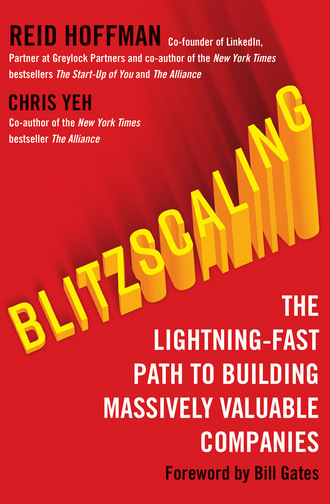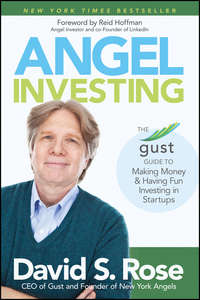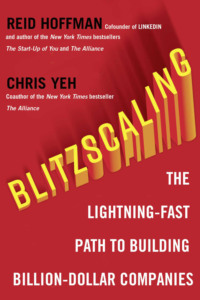
Полная версия
Blitzscaling
We also recognize that the number of employees is only one of several measures of an organization’s scale. Some of the other measures of scale include the number of users (user scale), the number of customers (customer scale), and total annual revenues (business scale). These measures usually, but don’t always, move in lockstep. While it’s nearly impossible to achieve customer scale or business scale without organizational scale—customers require customer service representatives, and revenues typically require salespeople—it is possible to achieve user scale without organizational scale. Consider the example of Instagram: when that company was acquired by Facebook for $1 billion, it had over one hundred million users but just thirteen employees and no significant revenues.
The fact that the phases don’t always move in lockstep is a feature of blitzscaling, not a bug. As we’ll discuss, operational scalability is one of the primary growth limiters that scale-ups need to address. When a business can grow users, customers, and revenues faster than the number of employees without collapsing under the weight of its own growth, the business can achieve greater profitability and keep growing without being as tightly constrained by the need for financial or human capital. In contrast, when the number of employees grows faster than users, customers, and revenues, it’s a major red flag that could indicate issues with the fundamental business model.
Nevertheless, for the sake of simplicity, this book will typically define the stage of a company by its organizational scale. A Family-stage company will have one to nine employees, a Tribe-stage company will have ten to ninety-nine employees, and so on. When exceptions arise, we’ll specifically call them out to avoid confusion.
THE THREE KEY TECHNIQUES OF BLITZSCALING
Through much study of, direct access to, and conversation with the leadership at companies such as Google, Amazon, and Facebook—and through my own experiences as an entrepreneur and an investor—we’ve been able to identify the three key techniques applied by entrepreneurs and investors to build dominant companies. These basic principles do not depend on geography and can be adapted to build great companies in any ecosystem, albeit with varying degrees of difficulty.
TECHNIQUE #1: BUSINESS MODEL INNOVATION
The first technique of blitzscaling is to design an innovative business model that can truly grow. This sounds like a Start-ups 101–level insight, but it’s astounding how many founders miss this key element. A major mistake made by many start-ups around the world is focusing on the technology, the software, the product, and the design, but neglecting to ever figure out the business. And by “business” we simply mean how the company makes money by acquiring and serving its customers. In contrast, despite the popular “engineers are gods” narrative prevalent in Silicon Valley, the companies and founders we universally hail as geniuses aren’t just technology nerds—they’re almost always business nerds too. At Google, Larry Page and Sergey Brin built great search algorithms, but it was their innovations to the search engine business model—specifically, considering relevance and performance when displaying advertisements rather than simply renting space to the highest bidder—that drove their massive success.
As the world has gone digital, business model innovation has become even more important. So many technologies are available as services, which are on demand and built to be integrated, that technology is no longer as strong a differentiator, while figuring out the right combinations of services to bring together into a breakthrough product has become a major differentiator. Most of today’s successful companies are more like Tesla, which combines a set of technologies that already existed, rather than SpaceX, which had to pioneer new ones.
Business model innovation is how start-ups are able to outcompete established competitors who typically hold a host of advantages over any upstarts. As a start-up, Dropbox competes with giants like Microsoft and Google, who ought to have major advantages in technology, finance, and market power. Dropbox founder and CEO Drew Houston knows that his company can’t simply rely on better technology or outexecuting the competition: “If your playbook is the same as your competitor’s, you are in trouble, because chances are they are just going to run your playbook with a lot more resources!”
Drew had to design a better business model, in which the focus on sharing files means that the number of files Dropbox has to store (or in the past, pay Amazon to store) increases far more slowly than the value created for the customer and thus the revenues Dropbox can collect from those customers. Uber and Airbnb also built large businesses at incredible speed based on novel business models rather than unprecedented new technologies. If technological innovation alone were enough, federal research labs would produce $100 billion companies on a regular basis. Spoiler alert: they don’t.
This is not to say that technology innovation is unimportant. Technology innovation is the most common trigger for launching a new market or upending an existing one. Uber wasn’t the first company to try to improve the experience of hailing a taxi. But prior to the technological innovation of the smartphone, complete with wireless Internet connection and GPS-enabled location-based services, Uber’s business model simply wouldn’t have worked. These innovations reduced the friction for both driver and rider, making Uber’s core UberX ridesharing model a mass-market possibility for the first time.
Nor can companies afford to ignore technology innovation after they successfully blitzscale their way to City or Nation stage. Each and every one of the technology companies worth over $100 billion has used technology leadership to reinforce its competitive advantages. Amazon may have started as a simple online retailer with no unique technology, but today its technological prowess in cloud computing, automated logistics, and voice recognition help to maintain its dominance. In fact, the megacompanies built by blitzscaling are often the ones buying the technology innovators, much as Google bought DeepMind and Facebook bought Oculus.
Technology innovation is a key factor in retaining the gains produced by business model innovation. After all, if one technology innovation can create a new market, another technology innovation can render it obsolete, seemingly overnight. While Uber has achieved massive scale, the greatest threat to its future doesn’t come in the form of direct competitors like Didi Chuxing, though these are formidable threats. The greatest threat to Uber’s business is the technology innovation of autonomous vehicles, which could make obsolete one of Uber’s biggest competitive advantages—its carefully cultivated network of drivers—essentially overnight.
The key is to combine new technologies with effective distribution to potential customers, a scalable and high-margin revenue model, and an approach that allows you to serve those customers given your probable resource constraints.
Ideally, you design your business model innovation before you start your company. This is what happened when I cofounded LinkedIn. The key business model innovations for LinkedIn, including the two-way nature of the relationships and filling professionals’ need for a business-oriented online identity, didn’t just happen organically. They were the result of much thought and reflection, and I drew on the experiences I had when founding SocialNet, one of the first online social networks, nearly a decade before the creation of LinkedIn. But life isn’t always so neat. Many companies, even famous and successful ones, have to develop their business model innovation after they have already commenced operations.
PayPal didn’t have a business model when it began operations (I was a key member of the PayPal executive team). We were growing exponentially, at 5 percent per day, and we were losing money on every single transaction we processed. The funny thing is that some of our critics called us insane for paying customers bonuses to refer their friends. Those referral bonuses were actually brilliant, because their cost was so much lower than the standard cost of acquiring new financial services customers via advertising. (We’ll discuss the power and importance of this kind of viral marketing later on.)
The insanity, in fact, was that we were allowing our users to accept credit card payments, sticking PayPal with the cost of paying 3 percent of each transaction to the credit card processors, while charging our users nothing. I remember once telling my old college friend and PayPal cofounder/CEO Peter Thiel, “Peter, if you and I were standing on the roof of our office and throwing stacks of hundred-dollar bills off the edge as fast as our arms could go, we still wouldn’t be losing money as quickly as we are right now.” We ended up solving the problem by charging businesses to accept payments, much as the credit card processors did, but funding those payments using automated clearinghouse (ACH) bank transactions, which cost a fraction of the charges associated with the credit card networks. But if we had waited until we had solved this problem before blitzscaling, I suspect we wouldn’t have become the market leader.
TECHNIQUE #2: STRATEGY INNOVATION
The most obvious element of blitzscaling is the pursuit of extreme growth, which, when combined with an innovative business model, can generate massive value and long-term competitive advantage. Many start-ups believe they are pursuing a strategy of extreme growth, when in fact they have the goal and the wish for extreme growth but no understanding of an actual strategy that will get them there. To achieve your goals, you have to know what you plan to do and, just as important, what you plan not to do. Also, growth doesn’t create value in and of itself; for that, it has to be paired with a working business model. It’s easy to achieve extreme customer and revenue growth if your company sells $20 bills for $1, but “we’ll make it up in volume” won’t allow you to build any sustainable value.
For successful blitzscaling, the competitive advantage comes from the growth factors built into the business model, such as network effects, whereby the first company to achieve critical scale triggers a feedback loop that allows it to dominate a winner-take-all or winner-take-most market and achieve a lasting first-scaler advantage. For example, Uber’s strategy of aggressive city-by-city expansion allows its customers to hail rides with fewer delays than its competitors. Uber wants you to be able to get a ride faster with Uber than with anyone else. This attracts more customers, which attracts more drivers, which increases the liquidity of the marketplace, which allows customers to hail rides even more quickly, which attracts more customers, and so on. Early Uber investor Bill Gurley laid out Uber’s strategy in his 2012 blog post “All Markets Are Not Created Equal.”
As the company grows, they are able to facilitate more cars on the road, and along with their investment in route and load optimization, this allows for shorter and shorter pickup times. The experience gets better and better the longer they are in the market.
Blitzscaling goes beyond just a strategy of aggressive growth because it involves doing things that don’t make sense according to traditional business thinking, such as prioritizing speed over efficiency despite an uncertain environment. At the same time, blitzscaling also goes beyond just risk taking. It may be risky to bet the company, as Walt Disney did when he borrowed against his own life insurance to build Disneyland, but it’s not blitzscaling. Blitzscaling would have involved inefficiencies like paying construction crews to work twenty-four hours a day in order to get Disneyland open a few months earlier, or reducing ticket prices 90 percent to get to one million visitors faster—knowing that those one million visitors were networked to ten million more.
Here is one of the ruthless practices that has helped make Silicon Valley so successful: Investors will look at a company that is on an upward trajectory but doesn’t display the proverbial hockey stick of exponential growth and conclude that they need to either sell the business or take on additional risk that might increase the chances of achieving exponential growth. Achieving 20 percent annual growth, which would delight Wall Street analysts covering any other industry, simply isn’t enough to transform a start-up into a multibillion-dollar company fast enough. Silicon Valley venture capitalists want entrepreneurs to pursue exponential growth even if doing so costs more money and increases the chances that the business could fail, resulting in a bigger loss. Dropping below even 40 percent annual growth is a warning sign for investors.
This mindset can be difficult for people to understand. “Why should I risk it all and potentially blow up what is a successful, growing business?” they might rightfully ask. The answer is that blitzscaling businesses tend to play in winner-take-most or winner-take-all markets. The greater risk for a successful, growing business is to move too slowly and allow its competitors to win market leadership and first-scaler advantage.
Nokia is a great example of the cost of caution. In 2007, Nokia was the world’s largest and most successful maker of mobile phones, with a market capitalization of just under $99 billion. Then Apple and Samsung came blazing into the market. In 2013, Nokia sold its money-losing handset operations to Microsoft for $7 billion, and in 2016 Microsoft sold its feature phone assets and the Nokia handset brand to Foxconn and HMD for just $350 million. That’s a drop in value for Nokia’s mobile phone business from somewhere in the neighborhood of $99 billion to $350 million in less than a decade—a decline of over 99 percent.
At the time, Nokia’s decisions may have seemed to make sense. Nokia actually continued growing even after the launch of the iPhone and Google’s Android operating system. Nokia hit its peak in terms of unit volume when it shipped 104 million phones in 2010. But Nokia’s sales declined after that, and were surpassed by Android in 2011 and iPhone in 2012. By the time Nokia’s management realized the existential threat facing them, it was too late; even the desperation play of aligning themselves with Microsoft as its exclusive Windows Phone partner couldn’t reverse the decline.
Because blitzscaling often requires spending significant amounts of capital in ways that traditional business wisdom would consider “wasteful,” implementing a financial strategy that supports this aggressive spending is a critical part of blitzscaling. For example, Uber often uses heavy subsidies on both sides of the marketplace when it launches in a new city, lowering fares to attract riders and boosting payments to attract drivers. By paying out more than it takes in on those early trips, Uber is able to reach critical scale faster than a more conservative competitor. Given the winner-take-most nature of the ridesharing market, that “wasteful” spending has helped Uber achieve a dominant market position in the cities in which it operates. Of course, that strategy isn’t possible without the ability to raise massive amounts of capital on favorable terms. In Uber’s case, it has been able to raise nearly $9 billion between its founding and the writing of this book. At some point, Uber will have to demonstrate the ability to significantly improve its unit economics, or its investors will get very grumpy. This concern helps explain Uber’s significant investments in autonomous vehicle technology, which could eliminate its biggest expense—driver payments—in one fell swoop.
The willingness to take on the risks of blitzscaling is one of the major reasons why Silicon Valley has produced such a disproportionate share of blockbuster companies in comparison to other geographies. To be fair, it has also produced a disproportionate share of financial disasters—hence the word “risk” when talking about blitzscaling. But as the rise of juggernauts like Alibaba and Spotify illustrates, blitzscaling is also starting to take off around the world.
TECHNIQUE #3: MANAGEMENT INNOVATION
The final technique required for blitzscaling is management innovation. This is necessary because of the extreme strains placed on the organization and its employees by hypergrowth.
I am fond of pointing out to entrepreneurs and executives that “in theory, you don’t need practice.”
What I mean is that no matter how brilliant your business model and growth strategy, you won’t be able to build a real-world (i.e., non-theoretical) blockbuster company without a lot of practice. But that problem is magnified when you’re trying to blitzscale.
The kind of growth involved in blitzscaling typically means major human resources challenges. Tripling the number of employees each year isn’t uncommon for a blitzscaling company. This requires a radically different approach to management than that of a typical growth company, which would be happy to grow 15 percent per year and can take time finding a few perfect hires and obsessing about corporate culture. As we will discuss in more detail later in the book, companies that blitzscale have to rapidly navigate a set of key transitions as their organizations grow, and have to embrace counterintuitive rules like hiring “good enough” people, launching flawed and imperfect products, letting fires burn, and ignoring angry customers.
Over the course of this book, we’ll see how business model, growth strategy, and management innovation work together to form the high-risk, high-reward process of blitzscaling.
Конец ознакомительного фрагмента.
Текст предоставлен ООО «ЛитРес».
Прочитайте эту книгу целиком, купив полную легальную версию на ЛитРес.
Безопасно оплатить книгу можно банковской картой Visa, MasterCard, Maestro, со счета мобильного телефона, с платежного терминала, в салоне МТС или Связной, через PayPal, WebMoney, Яндекс.Деньги, QIWI Кошелек, бонусными картами или другим удобным Вам способом.





